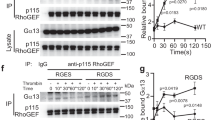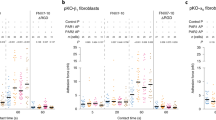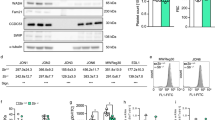Abstract
PLATELET membrane glycoprotein Ilb-IIIa (gpIIb-IIIa; αllb-β3), the most prominent member of the integrin family of adhesion receptors on these cells, mediates platelet aggregation by binding fibrinogen and is critical in thrombosis and haemostasis1-5. A short amino-acid sequence at the carboxy terminus of the γ chain of fibrinogen is recognized by gpIIb-IIIa (ref. 6) and peptides containing this sequence are selectively crosslinked to residues 294-314 of gpllb (ref. 7). Here we show that an 11-residue peptide from this region of gpllb inhibits platelet aggregation and binding of fibrinogen to platelets and to purified gpIIb-IIIa, and that it interacts directly with fibrinogen. These results implicate this segment of gpIIb-IIIa in the ligand-binding function of the receptor. Moreover, as this region is highly conserved among integrins, it may have a general function in ligand recognition by this broadly distributed family of adhesion receptors.
This is a preview of subscription content, access via your institution
Access options
Subscribe to this journal
Receive 51 print issues and online access
$199.00 per year
only $3.90 per issue
Buy this article
- Purchase on Springer Link
- Instant access to full article PDF
Prices may be subject to local taxes which are calculated during checkout
Similar content being viewed by others
References
Hynes, R. O. Cell 48, 549–554 (1987).
Phillips, D. R., Charo, I. F., Parise, L. V. & Fitzgerald, L. A. Blood 71, 831–843 (1988).
Plow, E. F. & Ginsberg, M. H. in Progress in Hemostasis and Thrombosis Vol. 9 (ed. Coller, B.S.) 117–156 (Saunders, Philadelphia, 1989).
Yasuda, T. et al. J. clin. Invest. 81, 1284–1291 (1988).
Akiyama, S. K., Nagata, K. & Yamada, K. M. Biochim. biophys. Acta 1031, 91–110 (1990).
Kloczewiak, M., Timmons, S., Lukas, T. J. & Hawiger, J. Biochemistry 23, 1767–1774 (1984).
D'Souza, S. E., Ginsberg, M. H., Burke, T. A. & Plow, E. F. J. biol. Chem. 265, 3440–3446 (1990).
Fitzgerald, L. A., Steiner, B., Rall, S. C. Jr, Lo, S.-S. & Phillips, D. R. J. biol. Chem. 262, 3936–3939 (1987).
Poncz, M. et al. J. biol. Chem. 262, 8476–8482 (1987).
Kretsinger, R. H. & Nockolds, C. E. J. biol. Chem. 248, 3313–3326 (1973).
Matsueda, G. R., Ball, E. L. & Bernatowicz, M. S. FASEB J. 2, 6480 (1988).
Plow, E. F., Pierschbacher, M. D., Ruoslahti, E., Marguerie, G. A. & Ginsberg, M. H. Proc. natn. Acad. Sci. U.S.A. 82, 8057–8061 (1985).
Ginsberg, M. H., Pierschbacher, M. D., Ruoslahti, E., Marguerie, G. & Plow, E. J. biol. Chem. 260, 3931–3936 (1985).
Haverstick, D. M., Cowan, J. F., Yamada, K. M. & Santoro, S. A. Blood 66, 946–952 (1985).
Gartner, T. K. & Bennett, J. S. J. biol. Chem. 260, 11891–11894 (1985).
Parise, L. V. & Phillips, D. R. J. biol. Chem. 260, 10698–10707 (1985).
Lam, C-T. et al. J. biol. Chem. 262, 947–950 (1987).
Bennett, J. S., Shattil, S. J., Power, J. W. & Gartner, T. K. J. biol. Chem. 263, 12948–12953 (1988).
D'Souza, S. E., Ginsberg, M. H., Burke, T. A., Lam, S. C-T. & Plow, E. F. Science 242, 91–93 (1988).
Loftus, J. C. et al. Science 249, 915–918 (1990).
Charo, I. F., Nannizzi, L., Phillips, D. R., Hsu, M. A. & Scarborough, R. M. Blood 74, 497a (1989).
Kobayashi, T., Takagi, T., Konishi, K. & Wnuk, W. J. biol. Chem. 264, 18247–18259 (1989).
Hemler, M. E. A. Rev. Immun. 8, 365–400 (1990).
Ginsberg, M. H. et al. J. biol. Chem. 262, 5437–5440 (1987).
Yamada, K. M. & Kennedy, D. W. J. cell. Physiol. 130, 21–28 (1987).
Akiyama, S. K. & Yamada, K. M. J. biol. Chem. 260, 10402–10405 (1985).
Marguerie, G. A., Edgington, T. S. & Plow, E. F. J. biol. Chem. 255, 154 (1980).
Plow, E. F., Pierschbacher, M. D., Ruoslahti, E., Marguerie, G. & Ginsberg, M. H. Blood 70, 110–115 (1987).
Pytela, R., Pierschbacher, M. D., Ginsberg, M. H., Plow, E. F. & Ruoslahti, E. Science 231, 1559–1562 (1986).
Author information
Authors and Affiliations
Rights and permissions
About this article
Cite this article
D'Souza, S., Ginsberg, M., Matsueda, G. et al. A discrete sequence in a platelet integrin is involved in ligand recognition. Nature 350, 66–68 (1991). https://doi.org/10.1038/350066a0
Received:
Accepted:
Issue Date:
DOI: https://doi.org/10.1038/350066a0
This article is cited by
-
In vivo imaging of integrin ανβ3 expression using fluorescence-mediated tomography
European Journal of Nuclear Medicine and Molecular Imaging (2007)
-
Platelet Integrin αIIbβ3-Ligand Interactions: What Can We Learn From the Structure?
International Journal of Hematology (2001)
-
The αMβ2 integrin and its role in neutrophil function
Cell Research (1999)
-
Hepatocyte-matrix interaction
Proceedings / Indian Academy of Sciences (1999)
-
Emerging paradigms of integrin ligand binding and activation
Kidney International (1997)
Comments
By submitting a comment you agree to abide by our Terms and Community Guidelines. If you find something abusive or that does not comply with our terms or guidelines please flag it as inappropriate.



